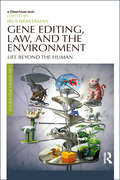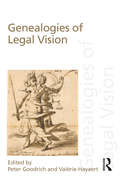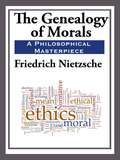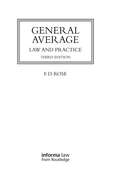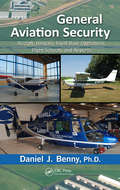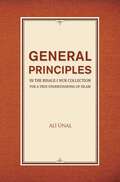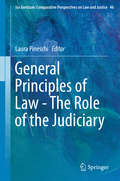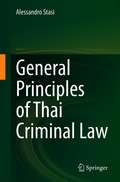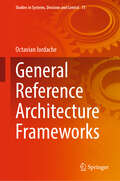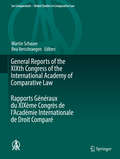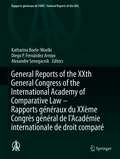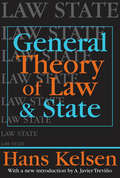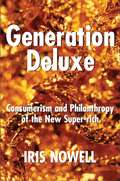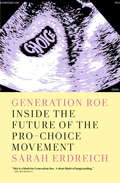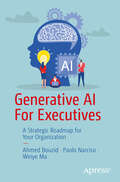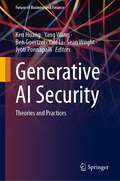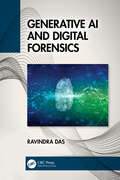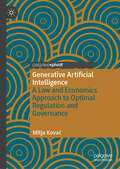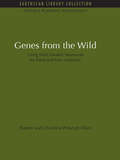- Table View
- List View
Gene Editing, Law, and the Environment: Life Beyond the Human (Law, Science and Society)
by Irus BravermanTechnologies like CRISPR and gene drives are ushering in a new era of genetic engineering, wherein the technical means to modify DNA are cheaper, faster, more accurate, more widely accessible, and with more far-reaching effects than ever before. These cutting-edge technologies raise legal, ethical, cultural, and ecological questions that are so broad and consequential for both human and other-than-human life that they can be difficult to grasp. What is clear, however, is that the power to directly alter not just a singular form of life but also the genetics of entire species and thus the composition of ecosystems is currently both inadequately regulated and undertheorized. In Gene Editing, Law, and the Environment, distinguished scholars from law, the life sciences, philosophy, environmental studies, science and technology studies, animal health, and religious studies examine what is at stake with these new biotechnologies for life and law, both human and beyond.
Genealogies of Legal Vision
by Peter Goodrich Valérie HayaertIt was the classical task of legal rhetoric to make law both seen and understood. These conjoint goals came to be separated and opposed in modernity and a degree of blindness ensued. Legal reason was increasingly deemed to be a purely textual enterprise. Against this constraint and in furtherance of an incipient visual turn in legal studies, Genealogies of Legal Vision seeks to revive the classical ars iuris and to this end traces the history of regimes of visual control. Law always relied in significant measure upon the use of visual representations, upon pictures, architecture, costume and statuary to convey authority and sovereign norm. Military, religious, administrative and legal insignia found juridical codification and expression in collections of signs of office, in heraldic codes, in genealogical devices, and then finally in the juridical invention in the mid-sixteenth century of the legal emblem book. Genealogies of Legal Vision traces the complex lineage of the legal emblem and argues that the mens emblematica of the humanist lawyers was the inauguration of a visiocratic regime that continues into the multiple new technologies and novel media of contemporary governance. Bringing together leading experts on the history and art of legal emblems this collection provides a ground-breaking account of the long relationship between visibility, meaning and normativity.
Genealogy Standards
by Board for Certification of GenealogistsHow do family historians know they are producing or receiving trustworthy results? This official manual from the Board of Certification for Genealogists, essentially a users' guide for family historians, provides standards for genealogical researchers to assess their own and others' work. <p><p>The revised second edition increases the clarity of DNA and privacy standards. Those standards are especially useful in the twenty-first century, when many genealogists use a complex new tool―DNA testing―and trace living people more often than they did in the past.
Geneaology of Morals
by Friedrich NietzscheMajor work on ethics, by one of the most influential thinkers of the last two centuries, deals with master/slave morality and modern man's current moral practices; the evolution of man's feelings of guilt and bad conscience; and how ascetic ideals help maintain human life under certain conditions.
General Average: Law and Practice (Lloyd's Shipping Law Library)
by Francis RoseAn account of the underlying law and the practical rules which govern the adjustment of rights and liabilities between parties to a maritime adventure when extraordinary measures have been incurred for the benefit of the common adventure. The third edition incorporates international case law developments to bring the text up to date and analyses the revision of the basic practical rules underlying general average adjustment internationally. It is essential for all those involved with maritime affairs to understand the implications of these new rules and how they fit with existing law and practice.
General Aviation Law (Third Edition)
by Jerry A. EichenbergerFully revised throughout, General Aviation Law, Third Edition, is an essential legal guide for those who work in aviation, including mechanics, pilots, aircraft owners, and aviation business owners. This practical reference answers all questions regarding aviation law in understandable layperson's terms.
General Aviation Security: Aircraft, Hangars, Fixed-Base Operations, Flight Schools, and Airports
by Ph.D, Daniel BennyAfter 9/11, the initial focus from the U.S. government, media, and the public was on security at commercial airports and aboard commercial airlines. Soon, investigation revealed the hijackers had trained at flight schools operating out of general aviation airports, leading to a huge outcry by the media and within the government to mandate security
General Defences in Criminal Law: Domestic and Comparative Perspectives (Substantive Issues in Criminal Law)
by Alan Reed Michael BohlanderThe law relating to general defences is one of the most important areas in the criminal law, yet the current state of the law in the United Kingdom reveals significant problems in the adoption of a consistent approach to their doctrinal and theoretical underpinnings, as exemplified by a number of recent developments in legislation and case law. A coherent and joined-up approach is still missing. This volume provides an analysis of the main contentious areas in British law, and proposes ways forward for reform. The collection includes contributions from leading experts across various jurisdictions. Part I examines the law in the United Kingdom, with specialist contributions on Irish and Scottish law. Part II consists of contributions by authors from a number of foreign jurisdictions, all written to a common research grid for maximum comparability, which provide a wider background of how other legal systems treat problems relating to general defences in the context of the criminal law, and which may serve as points of reference for domestic law reform.
General Interests of Host States in International Investment Law
by Giorgio Sacerdoti Pia Acconci Mara Valenti Anna De Luca Giorgio Sacerdoti Pia Acconci Mara ValentiSignatory States have the right to take action in order to maintain their financial stability, stimulate economic development or further their non-economic interests (such as health, the environment and food security). However, such measures can potentially conflict with the rights of foreign investors. Regulators and policy makers must take States' international commitments toward foreign investors into account when making decisions. They must also avoid resorting to protectionism in drafting new treaties. With this tension in mind, this book offers a balanced reappraisal of bilateral treaties and regional agreements on foreign investments. The sensitive issues are examined in the light of the case law of arbitral investment tribunals and other international courts, and the analysis highlights how cross-fertilisation between trade and investment can assist in resolving conflicts.
General Principles in the Risale-i Nur Collection for a True Understanding of Islam
by Ali UnalTheRisale-i Nur Collection is full of "general principles," not only related to the Islamic Jurisprudence but also to all the fields of Islam or Islamic life and Islamic branches of knowledge. Based on or specially favored with profound wisdom having its source in the Divine Wisdom or the Divine Name of the All-Wise, the Risale-i Nur Collection contains numerous principles, precepts, or maxims which are standards or brilliant criteria enabling people to think, believe, and live according to Islam, and to evaluate and judge things and events in Islam&’s light. They also provide people with the essentials or basic principles on which the branches of Islamic knowledge and Islamic science are based. Thus, we have tried to collect many of these principles in this book under certain titles, and in certain parts or sections according to the fields of thought and branches of knowledge to which they have a greater relevance.
General Principles of Law - The Role of the Judiciary
by Laura PineschiThis book examines the role played by domestic and international judges in the "flexibilization" of legal systems through general principles. It features revised papers that were presented at the Annual Conference of the European-American Consortium for Legal Education, held at the University of Parma, Italy, May 2014. This volume is organized in four sections, where the topic is mainly explored from a comparative perspective, and includes case studies. The first section covers theoretical issues. It offers an analysis of principles in shaping Dworkin's theories about international law, a reflection on the role of procedural principles in defining the role of the judiciary, a view on the role of general principles in transnational judicial communication, a study on the recognition of international law from formal criteria to substantive principles, and an inquiry from the viewpoint of neo-constitutionalism. The second section contains studies on the role of general principles in selected legal systems, including International Law, European Union Law as well as Common Law systems. The third section features an analysis of select legal principles in a comparative perspective, with a particular focus on the comparison between European and American experiences. The fourth and last section explores selected principles in given areas of law, including the misuse of the lex specialis principle in the relationship between international human rights law and international humanitarian law, the role of the judiciary in Poland as regards discrimination for sexual orientation, and the impact of the ECtHR case law on Italian criminal law with regard to the principle of legality. Overall, the book offers readers a thoughtful reflection on how the interpretation, application, and development of general principles of law by the judiciary contribute to the evolution of legal systems at both the domestic and international levels as well as further their reciprocal interactions.
General Principles of Thai Criminal Law
by Alessandro StasiThis book is centered around the major issues relating to criminal law in Thailand and aims to offer a detailed and systematic overview of the Thai criminal justice system. It is designed as a traditional textbook of criminal law which provides a succinct focused coverage of all the relevant aspects of laws, judgments, and legal reforms in a concise and readable form. Although all topics have been previously treated in the Thai language, this is the first and most comprehensive work in the English language about Thai criminal law. The book covers not only the legal system, starting from the Penal Code of 1908 and emphasizing the substantial changes that have been introduced in the past decades, but also the deep influence of doctrine and case law. It is built up in several layers, starting from the general rule, to gradually examine the more specific ones. The book begins with the elementary legal concepts to be learned by the reader, by defining the fundamental principles underlying the Thai criminal system and outlining its objectives. It then extensively describes the main offences under the Thai Penal Code and classifies those breaches of law which are crimes from those which are merely illegal without being criminal.
General Reference Architecture Frameworks (Studies in Systems, Decision and Control #73)
by Octavian IordacheStudying high complexity projects implementation is the object of this book. Multiple interactions and emergences are the core of higher complexity and of associated models and projects. The starting point of our approach is the observed similarity or isomorphism of roadmaps toward higher complexity and of reference architectures for different domains of reality. The objective is to propose a General Polytopic Roadmaps (GPTR) and a General Reference Architecture Framework (GRAF) and use these for 8D Program implementation. The GPTR shows the stages: 0D, 1D, 2D, 4D, and 8D. The book is divided into 8 chapters. Chapter 1 introduces the GRAF as a 4D of 4D polytope. Chapter 2 emphasizes the role for the dialogue of processes in duality, of the logic of contradiction, of iteration and of included middle to face high complexity. Chapter 3 refers to operations and equipments of engineering interest as permutations, mixings and separations. Chapter 4 refers to modeling and simulation. Chapter 5 concerns creative design models. Dual process design, and processes integration are presented. Industry 4.0, future developments to Industry 8.0 and chemical engineering paradigms are evaluated in Chapter 6. Chapter 7 focuses on complex systems as production systems of systems architecture frameworks, decision models, operations processes, and cyber-physical social systems. Chapter 8 discusses implementation of high complexity projects for different levels of reality. The book is useful to engineers, researchers, entrepreneurs, and students in different branches of production, science, and engineering of high complexity.
General Reports of the XIXth Congress of the International Academy of Comparative Law Rapports Généraux du XIXème Congrès de l'Académie Internationale de Droit Comparé
by Martin Schauer Bea VerschraegenThis book deals with convergences of legal doctrine despite jurisdictional, cultural, and political barriers, and of divergences due to such barriers, examining topics that are of vital importance to contemporary legal scholars. Written by leading scholars from more than twenty countries, its thirty-two chapters present a comparative analysis of cutting-edge legal topics of the 21st century. While each of the countries covered stands alone as a sovereign state, in a technologically advanced world their disparate systems nonetheless show comparable strategies in dealing with complex legal issues. The book is a critical addition to the library of any scholar hoping to keep abreast of the major trends in contemporary law. It covers a vast area of topics that are dealt with from a comparative point of view and represents the current state of law in each area.
General Reports of the XVIIIth Congress of the International Academy of Comparative Law/Rapports Généraux du XVIIIème Congrès de l’Académie Internationale de Droit Comparé
by Karen B. Brown David V. SnyderThis title presents twenty-nine topics, prepared by leading scholars in more than 20 countries, providing a comparative analysis of cutting-edge legal topics of the 21st century. Considering topics of vital moment to contemporary legal scholars, the title includes pieces on Surrogate Motherhood, The Balance of Copyright in Comparative Perspective, International Law in Domestic Systems, Constitutional Courts as "Positive Legislators," Same-sex Marriage, Climate Change and the Law, The Regulation of Private Equity, Hedge Funds, and State Funds, and Regulation of Corporate Tax Evasion. Each chapter surveys legal developments in the U.S. and Canada, Europe, Asia, Latin and South America, Africa, and the Middle East in a format that permits the reader easy access to similarities and differences in the approaches of the selected national regimes. This comprehensive volume tells the story of parallel trends in the evolution of legal doctrine despite jurisdictional, cultural, and political barriers. While each of the covered countries stands alone as a sovereign, in a technologically advanced world their disparate systems nonetheless have converged to adopt comparable strategies in dealing with complex legal issues. The volume is a critical addition to the library of any scholar hoping to keep abreast of the major trends in contemporary law.
General Reports of the XXth General Congress of the International Academy of Comparative Law - Rapports généraux du XXème Congrès général de l'Académie internationale de droit comparé (Ius Comparatum - Global Studies in Comparative Law #50)
by Diego P. Fernández Arroyo Katharina Boele-Woelki Alexandre SenegacnikThis book explores convergences of legal doctrine despite jurisdictional, cultural and political barriers, as well as divergences due to such barriers, examining topics that are of vital importance to contemporary legal scholars. Written by leading experts from all continents, its 26 chapters present a comparative analysis of cutting-edge legal issues of the 21st century. While each of the countries covered stands alone as a sovereign state, in a technologically advanced world their disparate systems nonetheless show comparable strategies in dealing with complex legal issues. Several of the chapters show how, in addition to state normative production and state adjudication, a growing panoply of non-state instruments and non-state adjudication are becoming more and more central to the legal field. This book is a key addition to the library of any scholar wanting to keep abreast of the major trends in contemporary law. Representing the current state of law in a vast range of areas, it covers each topic from a comparative perspective. Cet ouvrage, en examinant des sujets d'une importance vitale pour les juristes contemporains, traite des convergences de la doctrine juridique malgré les barrières juridictionnelles, culturelles et politiques ainsi que des divergences dues à ces barrières. Écrits par d'éminents universitaires de tous les continents, ses 26 chapitres présentent une analyse comparative de sujets juridiques majeurs du 21e siècle. Dans un monde technologiquement avancé, bien que chaque pays analysé dans cet ouvrage demeure autonome en tant qu'État souverain, l’ensemble des systèmes disparates présente néanmoins des stratégies comparables pour traiter des questions juridiques complexes. En outre, plusieurs chapitres montrent comment, en plus de la production normative et de la résolution des différends étatiques, la panoplie croissante de différents types d'instruments non étatiques et de résolution non étatique des différends devient de plus en plus centrale dans la sphère juridique. Cet ouvrage est un ajout essentiel à la bibliothèque de tout universitaire souhaitant se tenir au courant des principales tendances du droit contemporain. Il couvre un vaste domaine de sujets traités d'un point de vue comparatif et représente l'état actuel du droit dans chaque domaine.
General Theory of Law and State
by Hans KelsenWidely regarded as the most important legal theorist of the twentieth century, Hans Kelsen is best known for his formulation of the "pure theory of law", - within which the study of international law was his special field of work. The present volume, "General Theory of Law and State", first published in 1945, allowed Kelsen to adjust his pure theory of law to American circumstances after World War II. It also afforded him the opportunity to present to English-speaking readers his latest ideas on the supremacy of international law. The volume is divided into two parts: the first devoted to law, the second to the state. Together these topics constitute the most systematic and comprehensive exposition of Kelsen's jurisprudence. The volume is not only a compendium of Kelsen's lifework up to that time; it is also an extension of his theories, "to embrace the problems and institutions of English and American law as well as those of the Civil Law countries". Indeed, references to Continental European law are minimal compared with examples, scattered throughout the text, taken from the U.S. Constitution and several American court cases. This is more than a concession to American readers; it signifies that Kelsen's legal theory is truly general in that it accounts for the Common Law as well as the Civil Law. A systematic treatise on jurisprudence, "General Theory of Law and State" is a substantial reformulation of Kelsen's ideas articulated in several of his previous books, written in German. The juridical principles put forth by the most important legal theorist of the twentieth century remain of great value. This volume will be read by legal scholars, political scientists, and intellectual historians.
Generation Deluxe: Consumerism and Philanthropy of the New Super-Rich
by Iris NowellThey fork out 100 million for starter castles, 500,000 for a customized Mercedes, and 1.2 million for a watch. While Generation Deluxe explores the spending patterns of the wealthy, a dark underside emerges: excessive consumerism is creating serious damage to the environment and human life. Simultaneously, the super-rich - and celebrities - are raising awareness and spending multi-millions cleaning up the damage and, as never before, funding solutions to global problems of poverty, hunger, and disease prevention.
Generation Roe: Inside the Future of the Pro-Choice Movement
by Sarah ErdreichStrong support among women was key to Obama's reelection. At the start of his second term, it is time for Barack Obama, forty years after Roe v. Wade, to finally help lead us to demystify abortion. One-third of all American women will have an abortion by the time they are 45, and most of those women are already mothers. Yet, the topic remains taboo. In this provocative book on the heels of the Planned Parenthood controversy, Sarah Erdreich presents the antidote to the usual abortion debates. Inextricably connected to issues of autonomy, privacy, and sexuality, the abortion debate remains home base for the culture wars in America. Yet, there is more common ground than meets the eye in favor of choice. Generation Roe delves into phenomena such as "abortion-recovery counseling," "crisis pregnancy centers," and the infamous anti-choice "black children are an endangered species" billboards. It tells the stories of those who risk their lives to pursue careers in this stigmatized field. And it outlines the outrageous legislative battles that are being waged against abortion rights all over the country. With an inspiring spirit and a forward-looking approach, Erdreich holds abortion up, unabashedly, as a moral and fundamental human right.
Generative AI For Executives: A Strategic Roadmap for Your Organization
by Ahmed Bouzid Weiye Ma Paolo NarcisoIn the fast-evolving digital landscape, understanding the potential of generative AI is a strategic advantage. This book can serve as an easy to read introduction to the topic of the transformative power of AI in content creation, customer engagement, and operational efficiency. By deciphering complex AI concepts into practical insights, we empower decision-makers to envision innovative strategies, foster cross-industry collaborations, and navigate ethical considerations. The book will help executives and business decision makers to harness the immense potential of generative AI responsibly, ensuring data integrity and compliance while fostering a competitive edge. The book is focused on (1) Explaining in jargon-free language what Generative AI, and AI in general, (2) What problems they solve, and (3) What technologies make them possible.What You Will LearnHow generative AI models are built, how they generate new data or content, and the underlying algorithms powering these processesVarious practical applications of generative AI in business contextsThe challenges that could arise during the integration of generative AI into business processesWho This Book is ForThis book is meant to be bought and read by busy executives and business leaders
Generative AI Security: Theories and Practices (Future of Business and Finance)
by Sean Wright Ben Goertzel Yang Wang Ken Huang Yale Li Jyoti PonnapalliThis book explores the revolutionary intersection of Generative AI (GenAI) and cybersecurity. It presents a comprehensive guide that intertwines theories and practices, aiming to equip cybersecurity professionals, CISOs, AI researchers, developers, architects and college students with an understanding of GenAI’s profound impacts on cybersecurity. The scope of the book ranges from the foundations of GenAI, including underlying principles, advanced architectures, and cutting-edge research, to specific aspects of GenAI security such as data security, model security, application-level security, and the emerging fields of LLMOps and DevSecOps. It explores AI regulations around the globe, ethical considerations, the threat landscape, and privacy preservation. Further, it assesses the transformative potential of GenAI in reshaping the cybersecurity landscape, the ethical implications of using advanced models, and the innovative strategies required to secure GenAI applications. Lastly, the book presents an in-depth analysis of the security challenges and potential solutions specific to GenAI, and a forward-looking view of how it can redefine cybersecurity practices. By addressing these topics, it provides answers to questions on how to secure GenAI applications, as well as vital support with understanding and navigating the complex and ever-evolving regulatory environments, and how to build a resilient GenAI security program. The book offers actionable insights and hands-on resources for anyone engaged in the rapidly evolving world of GenAI and cybersecurity.
Generative AI and Digital Forensics
by Ravindra DasIn today’s world, cybersecurity attacks and security breaches are becoming the norm. Unfortunately, we are not immune to it, and any individual and entity is at dire risk. The best and only thing that we can do is to mitigate the risks as much as much as possible so that they do not happen at all. But even when a security breach does indeed happen, the immediate reaction is to contain it so that it does not penetrate further into the information technology/network infrastructure. From there, mission-critical processes need to be restored, until the business can resume a normal state of operations, like it was before the security breach.But another key step here is to investigate how and why the security breach happened in the first place. The best way to do this is through what is known as “digital forensics”. This is where specially trained digital forensics investigators collect and comb through every piece of evidence to determine this. Eventually, the goal is then to use this evidence in a court of law so the cyberattacker can be made to answer for their crime and eventually be brought to justice.However, the area of digital forensics is a large one, and many topics around it can be covered. Also, generative AI is being used to not only help in the analysis of the evidence but also to help automate the digital forensics software packages that are available today. Therefore, in this book, the following is covered: Examples of security breaches and overview of digital forensics. How digital forensics can be used to investigate the loss or theft of data. An introduction to the SQL Server Database. A review of the SQL Injection Attack. How generative AI can be used in digital forensics.
Generative Artificial Intelligence: A Law and Economics Approach to Optimal Regulation and Governance
by Mitja KovačThis book takes a comparative law and economics approach to explore the role of public and private actors in regulating generative artificial intelligence. The book provides an introduction and context for the creation of new generative AI technologies, now understood to be the chief goal of the leading AI companies. As autonomous ‘super-intelligences’, these technologies are still an unknown entity which nevertheless have profound implications for liberal democracy, consumer choice mechanisms, mutual trust, and political legitimacy. This book explores the deep challenges posed for lawmakers and how we can achieve an optimal form of regulation and governance of such unreliable technologies. Chapters investigate possible hybrid modes of regulation, such as a co-regulatory approach between private AI companies and public actors in addressing the issue of misinformation spread. It also explores mixed types of regulation toward research on new forms of AI, arguing that different levels of systemic risk posed by different technologies must be accounted for. Different contemporary and historical contexts for the regulation of unprecedented technical innovation are also considered, and new suggestions for policy are presented. This book is a timely resource which will be of interest to researchers and practitioners in economic governance, law and regulation, artificial intelligence, and comparative law.
Generic Challenge: Understanding Patents, FDA and Pharmaceutical Life-Cycle Management (Fifth Edition)
by Martin a. VoetThis Fifth Edition of The Generic Challenge provides important new updates on current regulatory, legal and commercial issues affecting brand and generic pharmaceutical products, including new laws establishing generics for biologics, and changes brought about by the recently enacted America Invents Act. It explains clearly and understandably the roles of patents, FDA regulation of drugs and the Hatch Waxman Act in commercial drug development in light of generic challenges and how improvements in innovative drug products provide benefits to patients while extending the commercial lives of the drugs. There is simply no other book of its kind on this important subject.
Genes from the Wild: Using Wild Genetic Resources for Food and Raw Materials (Natural Resource Management Set)
by Robert Prescott-Allen Christine Prescott-AllenTomatoes could not be grown commercially without the help of their wild relatives. A single wild species of rice has helped double rice production in Asia. Wild silk-worms are enabling India to expand its silk industry. A wild carp with resistance to cold has been used to extend Soviet carp production further into the north. Wild genetic resources - the heritable characteristics of wild plants and animals - are used increasingly to improve domesticated crops and livestock and as new sources of food and of raw materials. But habitat destruction, over-exploitation and competition from introduced species is destroying many gene pools even before they have been identified. Genes from the Wild describes the growing contribution of wild genetic resources to the production of food and raw materials, describes their characteristics, explains the benefits and problems of using them and outlines the ways in which they are threatened and the measures being taken to conserve them. Originally published in 1988
